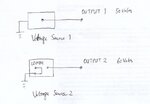toyonline
Member level 2
Hi, I have meet a confusing problem when try to measuring voltage difference between two independent voltage source. I used two dc voltage sources as separate port for my instrument. Either port could be regulated from 0-100V. The two port then were connected to electrodes that are separated apart from each other. Then I need to know what is the voltage difference between the two electrodes.
The two voltage was set to be 50V and 60V. I use a Fluke multimeter to measure voltage difference between each port and the GND. And I get the read 50V and 60 respectively, no problem here. Then I try to measure voltage difference between the two port. To my surprise, I read 0V from the multimeter. Theoretically, I should have a 10V like that.
I know that phenomenon is arising from the internal resistance of the multimeter (~10Mohm). But to what extent do I have to trust the multimeter? Why the port-to-GND voltage read is much more reasonable than port-to-port voltage read?And in my problem, if I want to know the voltage difference between the two port, what value should I trust? almost 0V or close to 10V?
Thank you.
The two voltage was set to be 50V and 60V. I use a Fluke multimeter to measure voltage difference between each port and the GND. And I get the read 50V and 60 respectively, no problem here. Then I try to measure voltage difference between the two port. To my surprise, I read 0V from the multimeter. Theoretically, I should have a 10V like that.
I know that phenomenon is arising from the internal resistance of the multimeter (~10Mohm). But to what extent do I have to trust the multimeter? Why the port-to-GND voltage read is much more reasonable than port-to-port voltage read?And in my problem, if I want to know the voltage difference between the two port, what value should I trust? almost 0V or close to 10V?
Thank you.
